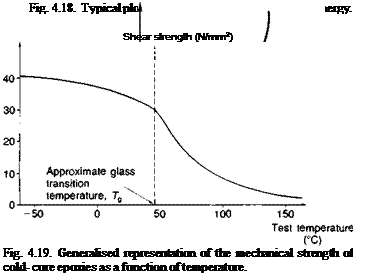It is apparent that the effects of moisture and heat, especially in combination with an applied stress, may have a considerable influence on bonded joint behaviour. This is because of changes in the stiffness of adhesive materials with exposure to environmental conditions, and the effect has been emphasised in previous sections.
The effects of temperature change only on joint strength fall into two categories. There is the general relation between the strength of a joint as a function of temperature, e. g. Fig. 4.19, and also as a
 |
function of the time during which a given temperature is sustained. For instance, chemical changes in the adhesive may occur due to prolonged periods at elevated temperature (thermal ageing), or else there may be a time-dependent strain associated with stress relaxation or creep of loaded joints. Time-temperature superposition techniques as applied to polymers and pioneered by Ferry(85), are described fully by Hunston et al. (86). Lark and Mays(87) found that the cold — cure epoxies that they worked with were generally amenable to
these procedures in bulk flexure. Further, the fracture behaviour of toughened epoxies may also be described using these techniques(88).
 5 августа, 2015
5 августа, 2015  Malyar
Malyar  Опубликовано в рубрике
Опубликовано в рубрике 